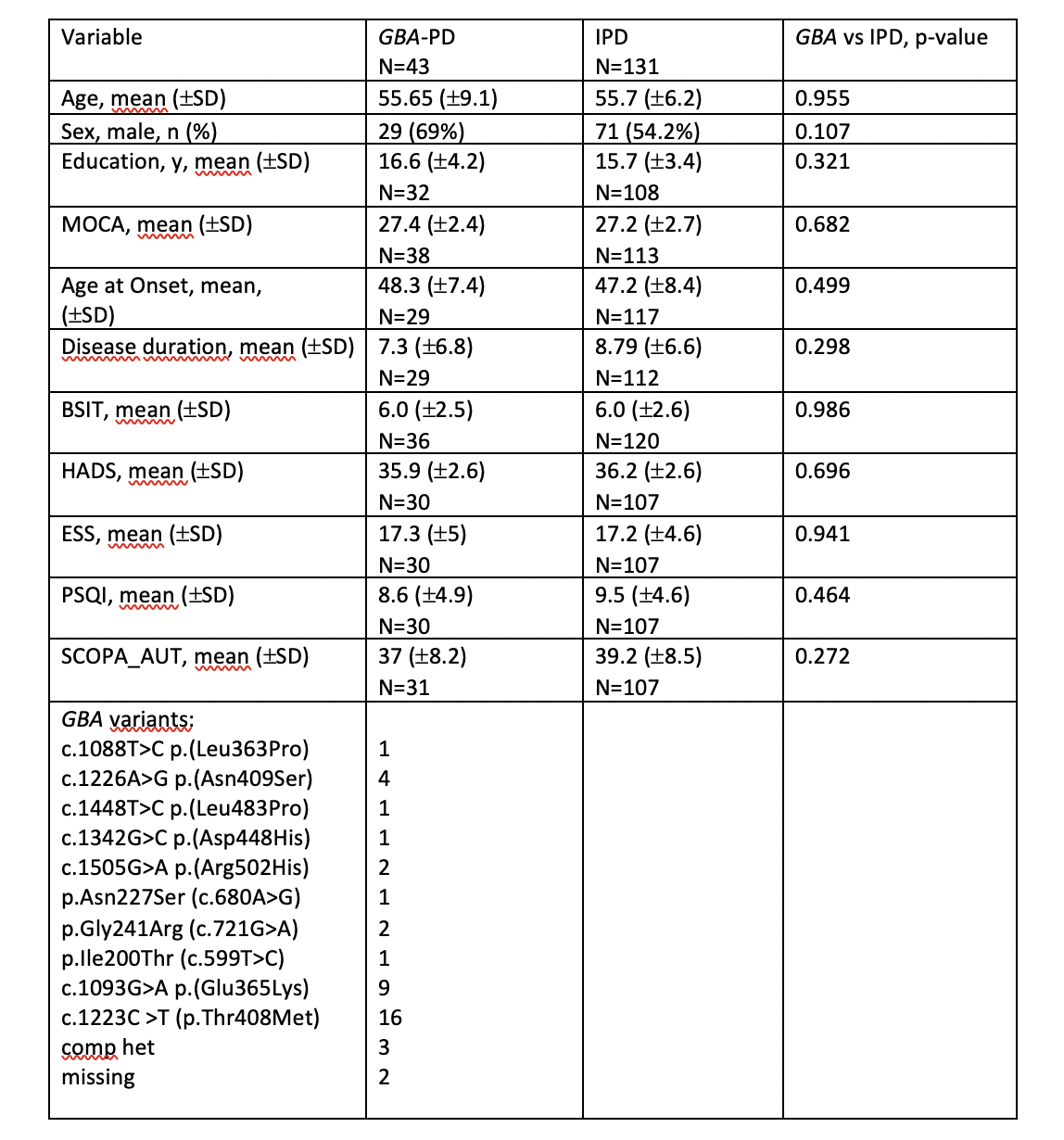Category: Parkinson's Disease: Genetics
Objective: Parkinson’s disease (PD) patients with pathogenic variants in the GBA (glucocerebrosidase) gene (GBA-PD) were reported to exhibit a younger age at onset, faster progression of motor signs, and more pronounced non-motor symptoms (NMS), such as cognitive decline and hyposmia, compared to idiopathic PD patients (IPD). These findings are predominantly based on patients carrying severe pathogenic variants, however, in clinical routine, counseling is typically performed irrespective of the type of variant (mild vs. severe).
We aimed to investigate the burden of NMS in GBA-PD due to mostly mild pathogenic GBA variants compared to IPD of similar age in a real-world setting.
Background: Variants in the GBA gene are the most common genetic risk factor for developing PD. In a large international genetic screening study including 1,360 participants, 8.5 % of the PD patients were found to carry heterozygous GBA variants. Depending on the variant, the risk of PD was reported to be increased, ranging from 1.78 to 10.49-fold across populations, varying significantly for specific variants and populations. However, whether the type of mutation also impacts disease expression and course remains largely elusive.
Method: We examined 43 patients with GBA-PD and 131 age- and sex-matched IPD patients with the protocol of the LIPAD (Lübeck International Parkinson’s Disease) Study. NMS were assessed using the Montreal Cognitive Assessment (MoCA), Brief Smell Identification Test (BSIT), Hospital Anxiety and Depression Scale (HADS), Epworth Sleepiness Scale (ESS), and Pittsburg Sleep Quality Inventory (PSQI).
Results: GBA variant carriers and IPD patients were matched according to age at examination, sex, age at onset of PD, and disease duration. We found no significant group differences in the results of the MoCA, BSIT, HADS, ESS, PSQI, and SCOPA-AUT tests or questionnaires (Table). GBA pathogenic variants are listed in the Table and were mostly mild.
Conclusion: The finding that GBA-PD due to mostly mild pathogenic variants and IPD did not significantly differ in NMS rate after 7 to 8 years of disease duration suggests that more caution is warranted when interpreting specific results of genetic testing and counseling GBA-PD patients.
To cite this abstract in AMA style:
T. Usnich, N. Brüggemann, M. Olmedillas, N. Schell, I. Csoti, S. Ertan, D. Gruber, S. Zittel, E. Sammler, S. Isaacson, A. Kühn, D. Pedrosa, K. Reetz, A. Sah, M. Kasten, P. Bauer, C. Klein. Frequency of non-motor symptoms in GBA-PD may differ in carriers of mild vs. severe pathogenic variants [abstract]. Mov Disord. 2022; 37 (suppl 2). https://www.mdsabstracts.org/abstract/frequency-of-non-motor-symptoms-in-gba-pd-may-differ-in-carriers-of-mild-vs-severe-pathogenic-variants/. Accessed October 13, 2025.« Back to 2022 International Congress
MDS Abstracts - https://www.mdsabstracts.org/abstract/frequency-of-non-motor-symptoms-in-gba-pd-may-differ-in-carriers-of-mild-vs-severe-pathogenic-variants/

